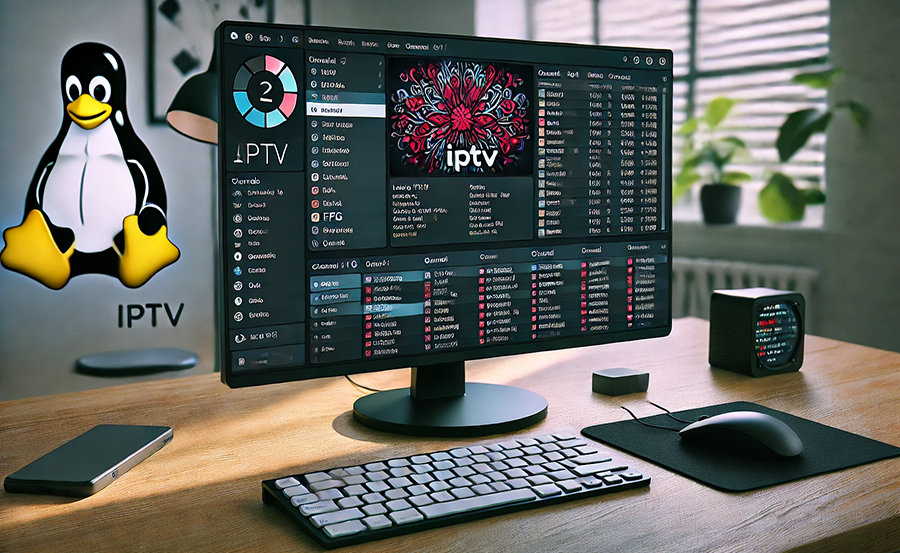In an age where streaming content has taken a monumental leap, managing IPTV playlists effectively has become a vital skill, especially for those using Linux. Whether you are tech-savvy or just beginning your IPTV ventures, understanding how to organize and navigate IPTV channels can significantly enhance your viewing experience.
Buy 1 Year IPTV Subscription and Enjoy Unlimited Content
Introduction to IPTV and Its Relevance
In recent years, IPTV, which stands for Internet Protocol Television, has notably transformed the way we consume media. Unlike traditional broadcast techniques, IPTV delivers content over the internet, making it both flexible and accessible. For users on Linux systems, the task of managing IPTV playlists might sound daunting initially, but it offers exciting prospects once you’re acquainted with the basics.
What is IPTV?
IPTV stands for Internet Protocol Television, a method of delivering television content over Internet Protocol networks. This form differs from traditional terrestrial, satellite signal, and cable television formats.
Streaming Tip:
Never miss your favorite matches with IPTV for sports streaming, offering crystal-clear live coverage.
IPTV provides the opportunity for streaming media in smaller batches directly from the source, offering greater freedom and choice for end users. It includes live television, time-shifted media, and video on demand (VOD). The ability to manage playlists effectively adds tremendous flexibility to how and when you consume media.
Why IPTV is Popular in the UK
IPTV has gained significant traction across the UK, primarily due to its promise of customized viewing experiences. With a diverse array of channels and content offerings, from sports to entertainment, IPTV gives users unparalleled control and access.
Given this, understanding how IPTV functions can enhance the consumer’s ability to tailor their media consumption more closely to their interests. Competitively priced options make IPTV particularly appealing compared to traditional cable services.
Setting Up IPTV on Linux
Initial Requirements
Before diving into playlist management, it is essential to ensure that your Linux system is ready for IPTV. The fundamental requirements include:
- A stable internet connection
- IPTV Smarters or any similar application compatible with Linux
- An updated media player such as VLC or SMPlayer
Installing Necessary Applications
One of the primary applications used for managing IPTV on Linux is IPTV Smarters. While there are other apps available, IPTV Smarters stands out for its user-friendly interface and efficient playlist management capabilities.
To install IPTV Smarters, one might consider using a package manager like Snap or Flatpak. Downloading applications through these managers simplifies the installation process, ensuring all dependencies are met.
Managing IPTV Playlists Effectively
Creating and Organizing Playlists
Organizing IPTV playlists can seem overwhelming initially. However, by following a structured approach, users can streamline their viewing experience significantly. Start by categorizing channels into various genres such as sports, news, or entertainment.
Once you have a basic structure, assign channels to each category. This organization helps in quick navigation, enabling viewers to jump between different genres without hassle.
Updating and Backup Procedures
Regular updates are crucial as IPTV links can change frequently. To ensure uninterrupted service, it’s recommended to update playlists periodically.
Furthermore, make it a habit to back up your playlists. In the event of a system failure or accidental deletion, having a backup ensures you don’t lose your meticulously organized playlists.
Using Tools for Enhanced Management
For those seeking advanced functionalities, several tools can facilitate better IPTV playlist management. Some applications allow for schedule-based recordings, while others enhance user experience with features like picture-in-picture mode.
Additionally, leveraging Linux’s robust command line can automate various tasks, such as updating playlists at scheduled intervals, thereby reducing manual input dramatically.
Enhancing IPTV Experience on Linux
Optimizing Video Quality
Managing IPTV on Linux doesn’t just stop at channel organization. Ensuring optimal streaming quality is equally important. Adjust settings in your media player to match your internet speed. This prevents interruptions and enhances the viewing experience.
It’s advisable to test various settings combinations to see what works best with your current setup.
Security Considerations
While IPTV is a highly convenient option, ensuring security is pivotal. Always connect to VPN services when accessing IPTV content on public networks. This adds a layer of protection by encrypting your online activities.
Moreover, choosing reputable IPTV providers reduces the risk of data breaches, keeping personal information secure.
Challenges in Managing IPTV Playlists and Overcoming Them
Common Issues and Solutions
Even seasoned IPTV users face challenges such as broken links, buffering, or poor video quality. Routine maintenance of playlists and regular checks for updated links can help mitigate these problems substantially.
Whenever you encounter persistent issues, revisiting your internet connection settings or reaching out to the IPTV service provider might provide resolution.
Dealing with Compatibility Issues
Another common problem is compatibility. Ensuring all software, including IPTV Smarters, is updated can sometimes resolve compatibility concerns.
Always check whether additional codecs are necessary for media players on Linux to run certain IPTV channels smoothly.
Exploring Advanced Features of IPTV on Linux
Integrations with Other Platforms
Modern IPTV services offer a range of integrations that users can leverage for improved functionalities. For instance, EPG integrations can enrich your TV-watching experience by providing detailed program guides.
Such integrations typically require additional configuration but are well worth the effort for enhanced capabilities.
Multitasking with IPTV
On Linux systems, users can benefit from multitasking features such as running multiple instances of a media player for watching various channels simultaneously. This can be particularly useful during significant sports events broadcasted live on different networks.
Experimenting with different media player settings might offer unique multitasking enhancements you weren’t previously aware of.
Future of IPTV and Linux
Emerging Trends
As technology continues to evolve, so does the landscape of IPTV. With 5G deployment, IPTV services are likely to become even faster and more reliable, pushing the boundaries of what’s possible with streaming.
For Linux users, staying updated with these trends is imperative to fully leverage the potential of IPTV advancements. And believe it or not, the more you familiarize yourself with new features, the better your overall experience will become.
The Impact of AI and Automation
AI and automation stand poised to redefine IPTV services further. Features like personalized recommendations and automated playlist updates are set to become the standard, offering users unprecedented convenience and customization.
While this may seem futuristic, the shift is already in motion. Those ready to adopt these technologies stand to gain significantly, enjoying a seamless, intuitive IPTV experience.
Visual Enhancement in IPTV through Linux
Exploring Customization Options
Customization is an often-underestimated feature when it comes to IPTV on Linux. Users have the flexibility to alter themes, skins, and layouts according to their taste. With open-source media players, the scope of customization is genuinely vast.
From interface tweaks to comprehensive overhauls, the options available can significantly enrich your IPTV consumption journey.
Including Subtitles and Multi-Language Options
Subtitles and multilingual support are integral for non-native speakers or for those consuming content in various languages. Many Linux-based media players come with robust subtitle options that support a wide range of languages.
Taking time to configure these settings ensures that language is never a barrier to enjoying diverse IPTV content.
Maximizing Efficiency in IPTV Playlist Management
Using Scripts and Automation
One of Linux’s greatest strengths is its capability for scripting and automation. Combining this with IPTV management can lead to significant efficiency improvements.
Scripts can automate common tasks such as daily playlist updates, backups, and system health checks. This can free up valuable time while ensuring your IPTV setup is in optimal condition.
Data Analysis for Informed Choices
Analysing viewing patterns and data can lead to insightful decisions about your IPTV usage. Whether it’s adjusting subscription tiers or aligning channel preferences, the data provides a pathway to informed decision-making.
Utilizing simple data logging tools available on Linux platforms can help track and analyze user activity, making invisible patterns visible.
Concluding Thoughts: Embracing Versatility
As we’ve seen, the world of IPTV on Linux is rich with possibilities. It offers a robust platform for media consumption that can be tailored to fit individual needs perfectly. By mastering the art of managing IPTV playlists, Linux users can look forward to a seamless, tailored viewing experience that is both rewarding and engaging.
Whether it’s future-proofing the system for upcoming trends or optimizing current setups, the future of IPTV on Linux holds significant promise for those willing to explore its full potential.
Frequently Asked Questions

What is the best IPTV player for Linux?
IPTV Smarters is a popular choice due to its user-friendly interface and compatibility with Linux. Other options include VLC and SMPlayer, which also offer robust features.
How can I keep my IPTV playlists updated?
Regular checks for broken or outdated links are crucial. Utilizing automation scripts can aid in updating playlists without manual intervention, providing a seamless experience.
Are there any legal concerns with using IPTV?
While IPTV itself is legal, accessing unauthorized channels can breach copyright laws. Always use reputable providers and verify content sources to ensure compliance.
Can I watch IPTV on multiple devices simultaneously?
This largely depends on your IPTV subscription terms. Some providers allow multiple simultaneous streams, while others may restrict it to a single device at a time.
How does VPN improve IPTV security?
A VPN encrypts your internet connection, protecting your data from prying eyes. This can significantly increase your security while accessing IPTV platforms.
Is Linux a good operating system for IPTV?
Absolutely. Linux offers a high degree of customization and scripting capabilities, which can greatly enhance IPTV management and playback experience.
Techniques for Solving Audio Sync Challenges in IPTV Streaming





